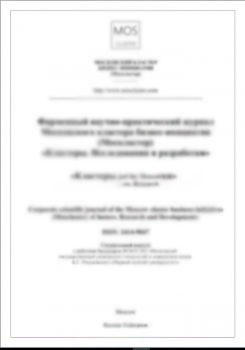Bryansk, Bryansk, Russian Federation
Bryansk, Bryansk, Russian Federation
GRNTI 50.07 Теоретические основы вычислительной техники
BBK 3297 Вычислительная техника
Remote sensing of the earth and monitoring of various phenomena have been and still remain an important task for solving various problems. One of them is the forest pathology dynamics determining. Assuming its dependence on various factors forest pathology can be either short-term or long-term. Sometimes it is necessary to analyze satellite images within a period of several years in order to determine the dynamics of forest pathology. So it is connected with some special aspects and makes such analysis in manual mode impossible. At the same time automated methods face the problem of identifying a series of suitable images even though they are not covered by clouds, shadows, turbulence and other distortions. Classical methods of nebulosity determination based either on neural network or decision functions do not always give an acceptable result, because the cloud coverage by itself can be either of cirrus intortus type or insignificant within the image, but in case of cloudiness it can be the reason for wrong analysis of the area under examination. The article proposes a new approach for the analysis and selection of images based on key point detectors connected neither with cloudiness determination nor distorted area identification, but with the extraction of suitable images eliminating those that by their characteristics are unfit for forest pathology determination. Experiments have shown that the accuracy of this approach is higher than of currently used method in GIS, which is based on cloud detector.
remote sensing of the earth, monitoring of forest pathology, image processing, descriptors of key points
1. Forest code of the Russian Federation as amended onDecember 27, 2018 (part 4, article 60.5)
2. The order of April 5, 2017 N 156 «On approval of the stateforest pathology monitoring procedure».
3. Showengerdt R. Remote sensing. Models and methods ofimage processing. M., 2010. 560 p.
4. Coluzzi, Rosa & Imbrenda, Vito & Maria, Lanfredi &Tiziana, Simoniello. (2018). A first assessment of theSentinel-2 Level 1-C cloud mask product to supportinformed surface analyses. Remote Sensing ofEnvironment. 217. 426-443. 10.1016/j.rse.2018.08.009.
5. Copernicus Open Access Hub. – URL:https://scihub.copernicus.eu.
6. Harris, C and Stephens, M (1988). ""A Combined Corner andEdge Detector"". Alvey Vision Conference
7. Hughes, M. J., Hayes, D. J. ""Automated detection of cloudand cloud shadow in single-date Landsat imagery usingneural networks and spatial post-processing"", RemoteSens., vol. 6, no. 6, pp. 4907-4926, 2014.
8. Jeppesen, J.H., Jacobsen, R.H., Inceoglu, F., Toftegaard,T.S. A cloud detection algorithm for satellite imagery basedon deep learning. Remote Sensing of Environment, 229,2019, pp. 247-259.https://doi.org/10.1016/j.rse.2019.03.039.
9. Kwan, C., Hagen, L., Chou, B. et al. Simple and effectivecloud- and shadow-detection algorithms for Landsat andWorldview images. SIViP, 2019, pp. 1-9.https://doi.org/10.1007/s11760-019-01532-2
10. Man D.C., Luu V.H., Hoang V.T., Bui Q.H., Nguyen T.N.T.(2015) Cloud Detection Algorithm for LandSat 8 ImageUsing Multispectral Rules and Spatial Variability. In:Nguyen VH., Le AC., Huynh VN. (eds) Knowledge andSystems Engineering. Advances in Intelligent Systems andComputing, vol 326. Springer, Cham
11. Pettorelli, N., Vik, J. O., Mysterud, A., Gaillard, J.-M.,Tucker, C. J., Stenseth, N. C. Using the satellite-derivedNDVI to assess ecological responses to environmentalchange // Trends in Ecology and Evolution. 2005. Vol. 20.P. 503–510. DOI: 10.1016/j.tree.2005.05.011.
12. Qi, J., Chehbouni, A., Huete, A.R., Kerr, Y.H., Sorooshian,S. A modified soil adjusted vegetation index. RemoteSensing of Environment. V. 48, № 2, 1994, pp. 119–126.
13. Rosten, Edward; Tom Drummond (2005). Fusing points andlines for high performance tracking. IEEE InternationalConference on Computer Vision. 2. pp. 1508–1511.CiteSeerX 10.1.1.60.4715. doi:10.1109/ICCV.2005.104.ISBN 978-0-7695-2334-7.
14. Scaramuzza, P.L., Bouchard, M.A., Dwyer, J.L.:Development of the Landsat data continuity mission cloudcover assessment algorithms. IEEE Trans. Geosci. RemoteSens. 50(4), 1140–1154 (2012)
15. Shi, J. and Tomasi, C. (June 1994). ""Good Features toTrack"". 9th IEEE Conference on Computer Vision andPattern Recognition. Springer. pp. 593–600. CiteSeerX10.1.1.36.2669. doi:10.1109/CVPR.1994.323794
16. Shiffman, S. Cloud detection from satellite imagery: acomparison of expert-generated and automaticallygenerated decision trees. In Proceedings of the EighthWorkshop on Mining Scientific and Engineering Datasets,held in conjunction with the 2005 SIAM InternationalConference on Data Mining, April 21-23, Newport Beach,CA, 2005.
17. Suzanne Angeli, Arnaud Quesney and Lydwine Gross(November 21st 2012). Image Simplification UsingKohonen Maps: Application to Satellite Data for CloudDetection and Land Cover Mapping, Applications of SelfOrganizing Maps, Magnus Johnsson, IntechOpen, DOI:10.5772/51352.
18. Tucker C. J. Red and photographic infrared linearcombinations for monitoring vegetation // Rem. Sens. ofEnv. 1979. Vol. 8. P. 127–150. DOI: 10.1016/0034-4257(79)90013-0.
19. Xie, F., Shi,M., Shi, Z., Yin, J., Zhao, D.: Multi-level CloudDetection in Remote Sensing Images Based on DeepLearning. IEEE J. Sel. Top. Appl. Earth Obs. Remote Sens.10(8), 3631–3640 (2017)
20. Zhu, Z., et al., Improvement and expansion of the Fmaskalgorithm: cloud, cloud shadow, and snow detection forLandsats 4–7, 8, and Sentinel 2 images, Remote Sensing ofEnvironment (2015),http://dx.doi.org/10.1016/j.rse.2014.12.014.
21. Zi, Y., Xie, F., Jiang, Z.: A cloud detection method forLandsat 8 images based on PCANet. Remote Sens. 10(6),877 (2018)





